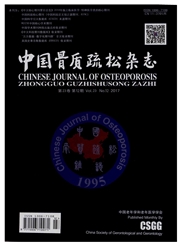

 中文摘要:
中文摘要:
目的为从整体动物水平研究碱性调宁蛋白(h1-calponin)在骨形成过程中的直接作用,我们构建了成骨细胞中特异性过表达h1—calponin的转基因小鼠模型,并对其表型进行了初步分析。方法构建在成骨细胞特异性启动子(collagen I promoter)驱动下表达h1—calponin的载体(pColl-calponin),纯化DNA片段,再以显微注射的方法将转基因片段导人小鼠受精卵,经移植后得到小鼠。PCR法检测整合到小鼠基因组中的外源基因,提取F1代阳性小鼠原代成骨细胞RNA,RT-PCR检测h1-calponin在小鼠成骨细胞中的表达情况,并观察转基因小鼠表型及体重变化情况。结果PCR检测结果显示1只Go代转基因鼠中检测到阳性信号,RT-PCR显示F1代转基因小鼠成骨细胞中表达h1—calponin较野生对照小鼠明显增加,且转基因小鼠体重与野生小鼠相比有明显降低。结论成功构建了在成骨细胞特异性过表达h1—calponin的转基因小鼠,为深入研究h1—calponin在骨骼发育中的作用提供了良好的动物模型。
 英文摘要:
英文摘要:
Objective This study reported the establishment of a transgenic mouse strain with osteoblast specific expression of h1-calponin. Methods hl-calponin cDNA driven by collagen I promoter was constructed and introduced into the mouse by nuclear microinjection, and offsprings were produced. DNA was isolated from the tails of the mouse pups, and was used to detect the incorporation of hl-calponin mini gene by PCR using hl-calponin specific primers. The h1-ealponin expression in osteoblast of transgenic mice was determined at mRNA level by RT-PCR. Results The PCR showed that there were one GO transgenic mice with positive signal. RT-PCR showed h1-calponin was expressed in the osteoblasts of F1 transgenic mice. Conclusion h1-calponin cDNA has been incorporated into the offspring mice. Meanwhile a significant expression of h1-calponin mRNA was detected in the osteoblasts of F1 transgenic mice which offered an useful animal model to study the biological function of h1- calponin in skeleton development and diseases.
 同期刊论文项目
同期刊论文项目
 同项目期刊论文
同项目期刊论文
 Gain-of-function mutation in FGFR 3 in mice leads to decreased bone mass by affecting both osteoblas
Gain-of-function mutation in FGFR 3 in mice leads to decreased bone mass by affecting both osteoblas Fibroblast growth factor receptor 1 regulates the differentiation and activation of osteoclasts thro
Fibroblast growth factor receptor 1 regulates the differentiation and activation of osteoclasts thro A Pro253Arg mutation in fibroblast growth factor receptor 2 (Fgfr2) causes skeleton malformation mim
A Pro253Arg mutation in fibroblast growth factor receptor 2 (Fgfr2) causes skeleton malformation mim 期刊信息
期刊信息
